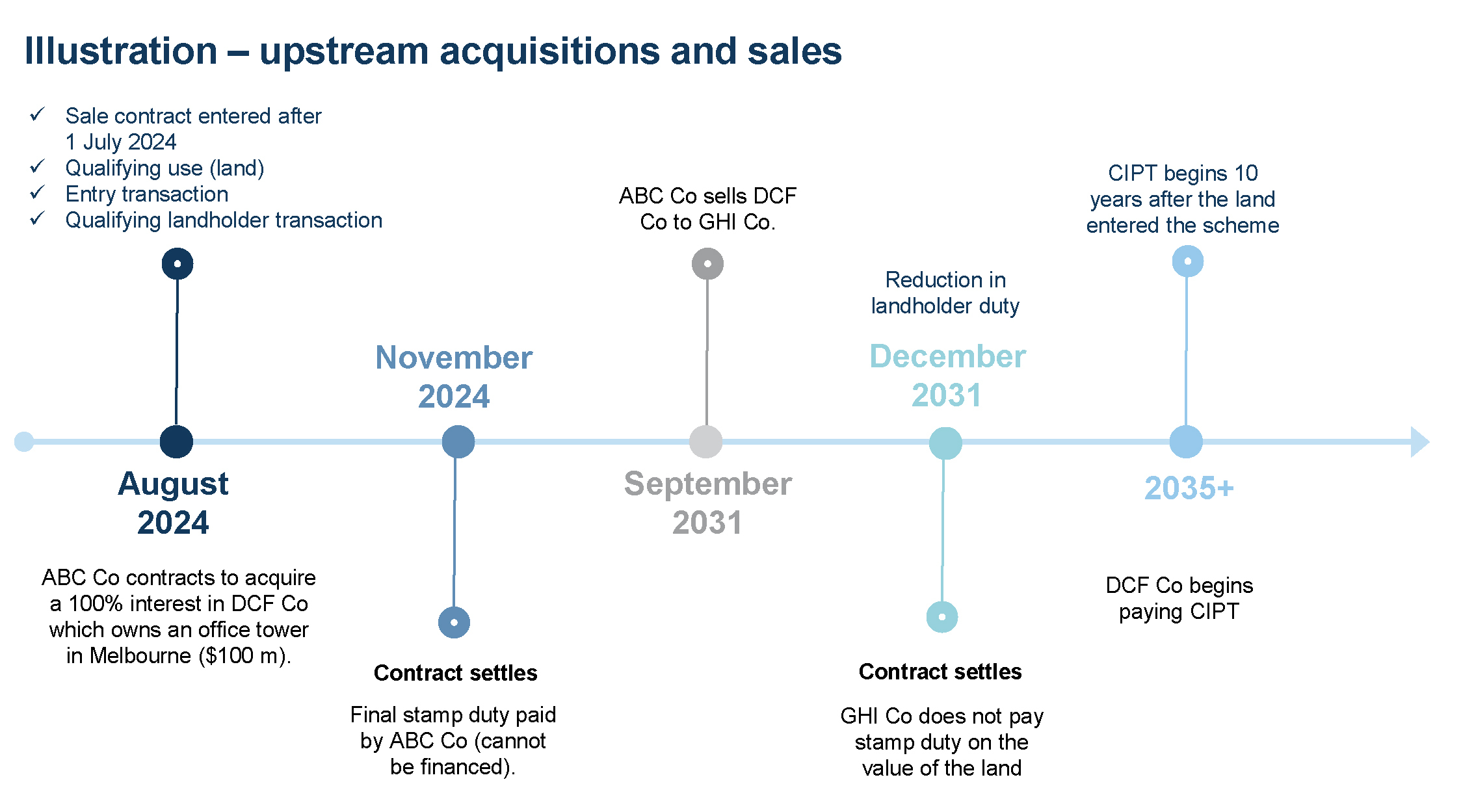The long-awaited details of Victoria’s stamp duty
reform have been released in the form of the Commercial and
Industrial Property Tax Reform Bill 2024 (Vic) (CIPT
Bill).
The Victorian Government is proposing to remove stamp duty on
dealings in relation to commercial and industrial land, and to
introduce in its place, a commercial and industrial property tax
(CIPT) chargeable annually. This publication
highlights some key complexities and implications for real estate
investors, financiers and developers.
Key provisions
The new scheme is proposed to broadly involve:
- the payment of stamp duty on eligible transactions after 1 July
2024 on one final occasion so long as the land remains subject to a
qualifying use; - the imposition of an annual CIPT at a general rate of 1% on the
unimproved value of CIPT taxable land commencing ten years after
the eligible transaction described above; - the provision of an exemption from subsequent stamp duty on a
transaction to which the scheme applies; - a reduction in the calculation of duty on dealings in a
landholder that holds scheme land; and - the availability of a ten-year transition loan from the
Victorian Government to eligible borrowers (anticipated to be
Australian residents for transactions with a value of up to $30
million) to assist with the funding of the final stamp duty
payment.
In short, over time dealings in certain commercial and
industrial land will fall outside the current stamp duty regime,
and instead the owner of that land will become subject to an annual
tax likely to be deductible for income tax purposes as is the case
for land tax currently on income producing land.
What land does the scheme apply to?
Under the proposal, commercial and industrial land will enter
the scheme if an entry transaction, an entry consolidation or an
entry subdivision occurs in relation to the land on or after 1 July
2024.
Contracts executed before 1 July 2024 fall outside the scheme
even if they complete after 1 July 2024, and commercial and
industrial land that is not the subject of one of the above entry
events will remain outside the new regime indefinitely.
What is commercial and industrial land?
Land will only enter the scheme if it has a qualifying use at
the date of the relevant entry transaction.
Classification approach
A “qualifying use” depends on how the property is
classified under the Australian Valuation Property Classification
Code (AVPCC). Under the Valuation of Land Act
1960 (Vic), an annual general valuation for all rateable and
non-rateable land as at 1 January in each calendar year must be
undertaken – this process includes allocating one or more
AVPCC to each property. The general valuation is primarily used for
rating, taxing and levying purposes.
Land that is allocated within the 200 – 499, and 600
– 699 ranges (generally, land that is regarded as falling
within the commercial, industrial, extractive industries or
infrastructure and utilities classifications) will have a
qualifying use.
Land that is allocated an AVPCC outside these ranges will not
have a qualifying use, unless a special rule applies. Broadly
speaking therefore, land that is regarded as residential, primary
production, community services, and sports, heritage and culture
are not proposed to be part of the scheme.
The one special exception relates to eligible student
accommodation (which would otherwise fall under the residential
AVPCC but which will be a qualifying use). An eligible student
accommodation is a property which is designed for occupation, and
is occupied or available for occupation, by students of a higher
education provider, if it is regarded as commercial residential
premises for GST purposes. Other commercial residential asset
classes such as retirement village, aged care, disability housing
does not appear to have a qualifying use and would therefore fall
outside of the scope of the scheme.
Build-to-rent
The CIPT Bill appears to suggest that the scheme will apply to
build-to-rent properties. For example, the Bill proposes a
concessional rate of CIPT (of 0.5% as compared to the general rate
of 1%) where the land is “BTR land”. However, it is not
immediately apparent from the current AVPCC that operational BTR
sites would fall within the qualifying AVPCC ranges – an
amendment may be required to specifically include BTR land (similar
to eligible student accommodation) if such properties are intended
to be within the new regime.
Mixed use
Land that is allocated more than one AVPCC (one or more of which
are outside the qualifying use range) will be classed as having a
qualifying use if the property is ‘solely or primarily’
used for the relevant commercial or industrial AVPCC. This is
likely to be relevant to mixed used properties.
How do you enter the tax reform scheme?
Land will enter the scheme if an entry transaction, an entry
consolidation or an entry subdivision occurs in relation to the
land on or after 1 July 2024.
Entry transaction
An entry transaction will occur where:
- the land is the subject of a qualifying dutiable transaction or
a qualifying landholder transaction; - the land has a qualifying use on the date of the transaction;
and - the transaction relates to an interest in land that is at least
50%, or which amounts to an interest of at least 50% under the
aggregation rules.
A qualifying dutiable transaction will include a transfer of
land or a declaration of trust over the land, but it will not
include a dutiable lease transaction or acquisition of an economic
entitlement.
A qualifying landholder transaction is, broadly speaking, a
transaction under which a relevant acquisition is made. A person
makes a relevant acquisition when the person (alone or with
associated persons) acquires a significant interest in a
landholder, or acquires a further interest after already holding a
significant interest. The significant interest threshold is 50%
where the landholder is a private company or wholesale unit trust,
and 20% for a private unit trust. This means that a person could
make a dutiable relevant acquisition of a 20% interest in a private
unit trust that holds qualifying land, without the land entering
the scheme as the 50% minimum transacted interest in relation to
the land is not satisfied.
A transaction that is eligible for an exemption from duty (for
example, change in trustee and transfer to a charity), or for a
corporate consolidation or reconstruction concession, will not be a
qualifying dutiable transaction or a qualifying landholder
transaction.
The date of entry into the scheme, which is relevant for
determining when the transition period ends, will generally be the
date when completion of the entry transaction occurs.
Consolidation and subdivision transactions
Land can also enter the scheme by a consolidation transaction or
a subdivision transaction.
A consolidation or subdivision will not, of itself, cause the
land to enter into the scheme. Rather, where there is a
consolidation or subdivision, it can incorporate additional parcels
of land into the scheme where the majority of the land being dealt
with is already within the scheme.
Land that is consolidated on or after 1 July 2024 will be scheme
land if at least 50% of the consolidated area comprises land that
had entered the scheme. The consolidated land is treated as having
entered the scheme on the earliest date on which land that forms
part of the consolidation entered the scheme.
However, land that has entered the scheme will cease to be
scheme land if it is consolidated with land that has not entered
the scheme, and as a result of the consolidation, less than 50% of
the area of the consolidated land is scheme land.
These principles also apply where two or more parcels of land
are consolidated as part of a subdivision.
Separately, a subdivision of scheme land will be an entry
subdivision and the child lots created from the parent lot will
also be treated as scheme land. The child lots will be treated as
having entered the scheme on the date on which the parent lot
entered the scheme.
What happens when land enters the scheme?
Once a property has entered the scheme (and therefore has become
scheme land):
- An exemption from stamp duty will apply to a subsequent
dutiable transaction in relation to the land, provided that the
land has a qualifying use at the time of the transaction and:- the transaction occurs at least three years after the land
entered the scheme; or - after a final stamp duty has been paid in respect of the
interest that is the subject of the transaction; and
- the transaction occurs at least three years after the land
- A reduction in landholder duty will apply to a relevant
acquisition in an entity that holds scheme land by excluding the
value of such land from the calculation of the dutiable value,
provided that the land has a qualifying use at the time of the
transaction.
CIPT will become payable on scheme land on the expiry of ten
years after its entry into the new regime. The cost of CIPT may be
a deductible expense for income tax purposes.
CIPT will not be charged on land that is exempt from land tax.
This may include for example, land that is used and occupied by a
charitable institution, land that is used as a registered caravan
park, and land that is used as a mine.
Change in use of tax reform scheme land
Where a change in use event occurs in relation to scheme land or
part of the land (ie it moves from a qualifying use to a
non-qualifying use, or vice versa), the owner of the land is
obliged to notify the Commissioner within 30 days of the change in
use event.
In the event that scheme land ceases to have a qualifying use, a
liability for duty will crystallise which will in effect operate to
clawback the stamp duty exemption or reduction provided by virtue
of the property’s previous qualifying use profile. This
liability is proposed to be determined based on the duty that would
have been payable if the land did not have a qualifying use, with a
10% reduction for each calendar year that has passed since the date
of the original transaction. For example, a change in use five
years after scheme land is transferred should mean that the duty
effectively payable in respect of the transfer is 50% of the duty
that would otherwise have been payable if the land did not have a
qualifying use at the time of the transfer.
In a landholder duty context, the notification obligations of a
person (an upstream acquirer) who made a relevant
acquisition of an entity that directly or indirectly held scheme
land that subsequently undergoes a change in use are unclear. The
Commissioner should have sufficient information to make an
assessment of the change in use duty payable by the upstream
acquirer based on the combined information from the change in use
notification made by the owner of the land and the acquisition
statement originally lodged by the upstream acquirer. Perhaps, an
upstream acquirer will not have a positive obligation to notify. If
this is the intended operation, it should provide upstream
acquirers with comfort that they will not inadvertently fail to pay
the change in use duty, particularly where they are not involved in
day-to-day operations of the landowner.

What are the implications for acquisition contracts?
Contracts for the sale and purchase of land
The CIPT Bill proposes to impose disclosure requirements on
vendors, including that the vendor’s statement must state
whether or not the land is scheme land (including its entry date)
and the AVPCC most recently allocated to the land. As indicated
above, this may require judgments to be made in relation to mixed
use land.
Property clearance certificates issued by the Commissioner will
state whether the land is a scheme land, when it became a scheme
land, and when the property became, or will become, subject to
CIPT. It will also include information on any CIPT (including
interest or penalty tax) due and unpaid.
At present, some but not all land information certificates
include information about the AVPCC allocated to a property. It is
unclear whether amendments will be made to the regulations made
under the Local Government Act 2020 to require the
inclusion of AVPCC details in a land information certificate.
As with land tax, it will be an offence for a vendor to enter
into a contract of sale for a sale price less than the threshold
amount (as at the date of this article, $10 million) to the extent
that it purports to require the purchaser to pay an amount towards
CIPT that the vendor is, or may become, liable for in respect of
the land. Such a provision will be of no effect.
Agreement for leases
Lessors will be prohibited from passing on CIPT to residential
and retail tenants.
However, there does not appear to be any such prohibition in
relation to other tenants, meaning that subject to the terms of the
lease, a lessor should be able to pass on CIPT to commercial or
industrial tenants (for example, of an office or warehouse).
What is the transition loan program?
The Victorian Government is proposing to provide a ten-year
transition loan program to eligible participants who choose to take
up this loan. The CIPT Bill does not include details of the
program, but empowers the Treasurer to publish a transition loan
notice detailing eligibility criteria and relevant terms and
conditions.
The Treasurer has not yet released a transition loan notice.
Based on an information sheet published by the Government
however, the loans are likely to have the following features:
repayments on an annual basis over a ten year period, an interest
rate equal to the Treasury Corporation of Victoria’s bond rate
plus a credit risk margin, break fee payable on an early repayment,
and the loan must be repaid on a sale of the land or change to
non-qualifying use.
It is anticipated that eligible participants will be Australian
residents who are the first purchaser on or after 1 July 2024 of a
commercial or industrial property for up to $30 million.
The transition loan amount owing will be a statutory first
charge on the land. Discussions about this charge will therefore be
required with financiers who may otherwise have provided funding
for the stamp duty amount in addition to the purchase price as part
of the overall facility.
Final thoughts
The new scheme is slated to commence on 1 July 2024, just three
months away. While its concept, at a high-level, is simple, there
is likely to be considerable difficulty and uncertainty in its
practical application. At first blush, the proposed law appears
complex and its application is likely to become increasingly more
complex where, for example, land (or its owner) is transacted over
time, particularly where fractional interests are involved, and as
land becomes subject to changes in use.
The earliest that the Bill will be next considered in Parliament
is its next sitting date on 30 April 2024. Watch this space.
The content of this article is intended to provide a general
guide to the subject matter. Specialist advice should be sought
about your specific circumstances.
 |
 |
| Lawyers Weekly Law firm of the year
2021 |
Employer of Choice for Gender Equality
(WGEA) |
#Removal #stamp #duty #Victorian #commercial #industrial #property #Unpacking #proposed #law #Property #Taxes






